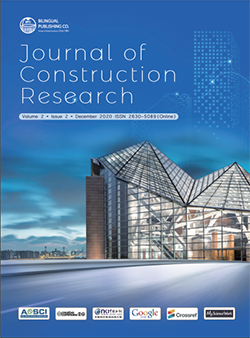BIM and Design Briefing Integration: Feasibility Study and Conceptual System Framework Development
DOI:
https://doi.org/10.30564/jcr.v3i1.2960Abstract
Design briefing plays a crucial role to the success of a building project. Some new methods of design briefing have been developed recently, but rarely integrated with Building Information Modelling (BIM). This paper presents a feasibility study of implementing BIM in the design briefing and develop a conceptual system framework to present possible functionalities and processes of BIM-based design briefing. This study started with a series of the interviews with professionals in the industry as well as academics in various universities in the UK. A thematic analysis has been carried out to analyse the interview transcripts. The development of conceptual system framework following the software engineering method presents the major functional modules and relevant datasets of an BIM-based design briefing system which identified in the interviews. The paper also discusses on both the benefit and the potential difficulties of BIM-based design briefing, although 93 % of the interviewees agree that BIM technology should be adopted in design briefing to improve the quality of design briefing process and to involve other stakeholders and POE data in design briefing.
Keywords:
Design briefing, conceptual design, BIM, stakeholder collaboration, POEReferences
[1] Barrett,P.,Hudson,J.& Stanley,C.(1999).Good practice in briefing: the limits of rationality.Automation in construction.8(6),p.633-642.
[2] Kamara,J.M.,Anumba, C.J.& Hobbs,B.(1999).From briefing to client requirements processing. Association of Researchers in Construction Management,1,p.317-326.
[3] Shen,Q.,Li,H.,Chung,J.&Hui,P.(2004).A framework for identification and representation of client requirements in the briefing process.Construction Management and Economics,22(2),p.213-221.
[4] Latham,M.(1994).Constructing the team: Joint Review of Procurement and Contractual Arrangements in the United Kingdom Construction Industry.1st ed. London: HMSO
[5] Barrett,P.& Stanley,C.(1999).Better construction briefing.Oxford:Blackwell Science.
[6] Sailsbury,F.(1998). Briefing your architect.2nd ed.Oxon: Routledge.
[7] Tunstall,G.(2007).Managing the building design process.2nd ed.Oxford: Butterworth-Heinemann.
[8] Bogers,T.,Meel,J.V.and Voordt,T.J.M.(2008).Architects about briefing: Recommendations to improve communication between clients and architects.Facilities.26 (3/4),p.109-116.
[9] Chung,J.K.H.,Kumaraswamy,M.M.and Palaneeswaran,E.(2009).Improving megaproject briefing through enhanced collaboration with ICT. Automation in construction.18(7),p.966-974.
[10] Hansen,K.L.and Vanegas,J. A.(2003).Improving design quality through briefing automation. Building Research and Information,31(5),p.379-386.
[11] Murphy,E.& Hands,D.(2012).Wisdom of the crowd: How participatory design has evolved design briefing. Swedish Design Research Journal. 12(2), p.28-37.
[12] Ryd,N.(2004).The design brief as a carrier of client information during the construction process.Design Studies,25(3),p.231-249.
[13] Yu,A.T.W.,Shen,Q.,Kelly,J.& Hunter,K.(2006).Investigation of critical success factors in construction project briefing by way of content analysis. Journal of Construction Engineering and Management,132(11),p.1178-1186.
[14] Koutamanis,A.(2017).Briefing and building information modelling:Potential for integration. International Journal of Architectural Computing.15(2),p.119-133.
[15] Norouzi,N.,Shabak,M.,Embi,M.R.B.& Khan,T.H.(2015).The architect,the client and effective communication in architectural design practice.Procedia–Social and Behavioural Sciences,172,p.635-642.
[16] Ryd,N.and Fristed,S.(2007).Transforming strategic briefing into project briefs,Facilities,25(5),p.185-202.
[17] Banwell,Sir H.(1964).The placing and management of contract for building and civil engineering work.London:HMSO.
[18] RIBA (2020a).Stage 0: Strategic definition.[Online].Available at:https://www.architecture.com/-/media/GatherContent/Test-resources page/Additional Documents/0strategicdefinitionchecklistpdf.pdf [Accessed: 03/10/2020].
[19] RIBA (2020b).Stage 1: Preparation and brief. [Online]. Available at:https://www.architecture.com/-/media/GatherContent/Test-resources-page/Additional Documents/1PreparationandBriefchecklistpdf.pdf [Accessed: 03/10/2020].
[20] Wohlin,C.,Höst,M.& Henningsson,.K.,2003.In:Empirical Research Methods in Software Engineering.In:Conradi,R.&Wang,A.I..Berlin: Springer-Verlag.
[21] Sommerville,I.(2016)Software Engineering.10th ed.Essex: Pearson.
[22] RIBA (2020).RIBA Plan of Work 2020 Overview.London: RIBA.
[23] Ostime,N.(2020).RIBA Job book.10th ed.London:RIBA Publishing.
[24] Meel,J.V.and Størdal,K,B.(2017).Briefing for Buildings: A practical guide for clients and their design teams.1st ed.Netherlands:ICOP.
[25] Vanlande,R.,Nicolle,C.&Cruz,C.(2008).IFC and building lifecycle management. Automation in Construction,18(1),p.70-78.
[26] Eadie,R.,Browne,M.,Odeyinka,H.,McKeown,C.& McNiff,S.(2013).BIM implementation throughout the UK construction project lifecycle: An analysis. Automation in Construction,36,p.145-151.
[27] Barnes,P.& Davies,N.(2015).BIM in principle and in practice. 2nd ed. London: ICE.
[28] Sacks,R.,Eastman,C.,Lee,G.&Teicholz,P.(2018).BIM Handbook:A guide to building information modelling for owners,designers,engineers,contractors,and facility managers.3rd ed.New Jersey:John
[29] Wiley&Sons.
[30] Shen,W.,Zhang,X.,Shen,G.Q.&Fernando,T.(2013).User pre-occupancy evaluation method in designer-client communication in early design stage:A case study.Automation in Construction,32,p.112-
[31]
[32] Baldauf,J.P.,Formoso,C.T.,Tzortzopoulos,P.,Miron,L.I.G.&Soliman_Junior,J.(2020).Using building information modelling to manage client requirements in social housing projects.Sustainability,
[33] (7), 21.
[34] Creswell,J.W.(2013).Qualitative enquiry and research design:Choosing among five traditions.3rd ed.London:Sage Publications.
[35] Braun,V.& Clarke,V.(2006). Using thematic analysis in psychology. Qualitative Research in Psychology,3(2),p.77-101.
[36] Nowell,L.S.,Norris,J.M.,White,D.E.& Moules,N.J.(2017).Thematic analysis:Striving to meet trustworthiness criteria.International Journal of Qualitative Methods,16(1),p.1-13.
[37] Enoma,A.(2005).The role of facilities management at the design stage.In: Khosrowshahi,F (Ed.),21st Annual ARCOM Conference,7-9 September 2005,SOAS, University of London. Association of Researchers in Construction Management,1,p.421-30.
[38] RIBA and Hay,R.,Bradbury,S.,Dixon,D.,Matindale,K.,Samuel,F.& Tait,A.(2016).Pathways to POE.University of Reading:RIBA.
[39] Dowlatshahi,S.(1998).Implementing early supplier involvement:A conceptual framework.International Journal of Operations and Production Management,18(2),p.143-167.
[40] Valkenburg,M.V.,Lenferink,S.,Nijsten,R.& Arts,J.(2008).Early contractor involvement: a new strategy for‘buying the best’in infrastructure development in The Netherlands.Proceedings of the 3rd International Public Procurement Conference.28-30 August 2008.
Downloads
Issue
Article Type
License
Copyright and Licensing
The authors shall retain the copyright of their work but allow the Publisher to publish, copy, distribute, and convey the work.
Journal of Construction Research publishes accepted manuscripts under Creative Commons Attribution-NonCommercial 4.0 International License (CC BY-NC 4.0). Authors who submit their papers for publication by Journal of Construction Research agree to have the CC BY-NC 4.0 license applied to their work, and that anyone is allowed to reuse the article or part of it free of charge for non-commercial use. As long as you follow the license terms and original source is properly cited, anyone may copy, redistribute the material in any medium or format, remix, transform, and build upon the material.
License Policy for Reuse of Third-Party Materials
If a manuscript submitted to the journal contains the materials which are held in copyright by a third-party, authors are responsible for obtaining permissions from the copyright holder to reuse or republish any previously published figures, illustrations, charts, tables, photographs, and text excerpts, etc. When submitting a manuscript, official written proof of permission must be provided and clearly stated in the cover letter.
The editorial office of the journal has the right to reject/retract articles that reuse third-party materials without permission.
Journal Policies on Data Sharing
We encourage authors to share articles published in our journal to other data platforms, but only if it is noted that it has been published in this journal.




 Changfeng Fu
Changfeng Fu


